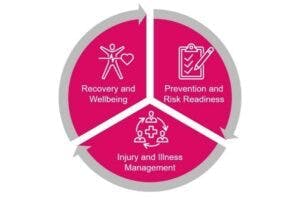Reducing Workers' Compensation Claims and Costs with Circle of Care
By Robin Hendrickson | Published August 19, 2019

Last month, I was invited to speak at the Hospitality Finance & Technology Professionals, Monterey Chapter meeting. My presentation focused on workers’ compensation, emerging risk management trends, and employer risk mitigation strategies. The audience composed mostly of finance, human resources, risk managers and technology specialists in the hospitality industry was intrigued by my perspective on reducing workers’ comp claims and actively engaged with the idea of proactive risk mitigation and employee support.
As the SVP of Newfront’s Occupational Health and Safety division, I have spent a lot of time with my team developing an integrated workers’ compensation and wellness service model we call Circle of Care. Circle of Care is a multidisciplinary approach to managing and reducing workers’ compensation claims based on three core areas: Prevention and Risk Readiness, Injury and Illness
Newfront’s Occupational Health and Safety practice focuses on the philosophy of wellbeing, safety and health of our clients’ employees simply because it costs more money not to. Work related stress costs employers over billion each year, and health promotion programs have been shown to reduce related workers’ compensation and disability claims between 15% and 25%. Even more, we’ve found that investing in proactive return-to-work programs, like Circle of Care, can yield up to 0 in returned savings per dollar.
Returns on investments in injury prevention, quality health care, employee wellbeing and return-to-work programs will likely continue to rise, as the state of California’s workers’ compensation system continues to experience a significant increase in cumulative trauma claims, including musculoskeletal disorders (MSD) that are the single largest category of workplace injuries and 30% of all WC claims costs. Many causes contribute to MSDs both on and off the job, including repetitive tasks, lifting objects, prolonged sitting, as well as aging, pre-existing health conditions, and unhealthy lifestyles that may contribute to higher costs associated with workers’ compensation claims, increased lost workdays, and reduced overall performance. Working cross-functionally with risk management, human resources, environmental health and safety, benefits, and finance teams within their organization, employers can address the trend of musculoskeletal disorders that can impede the recovery of a WC claim, reduce productivity and negatively impact employee health.
Newfront encourages employers to be proactive about their employees’ health and wellbeing to both reduce the cost of workers’ compensation claims and also boost workplace morale. For more information on Circle of Care and our Occupational Health and Safety services, contact us today.
Statistics were sourced from the following organizations: Workers’ Compensation Rating Bureau, Centers for Disease Control and Prevention, NIOSH Total Worker Health, Department of Industrial Relations/Cal OSHA, National Safety Council, and the American Institute of Stress.

Robin Hendrickson
As Newfront’s Occupational Health & Safety practice leader, Robin leads a team of experienced workers’ compensation claims management, wellness initiative, and loss mitigation and strategy consultants. Robin, and her team, work with employers to reduce occupational risk exposures, implementing best practices to control claim costs, and keeping employees safe, healthy, and productive.



